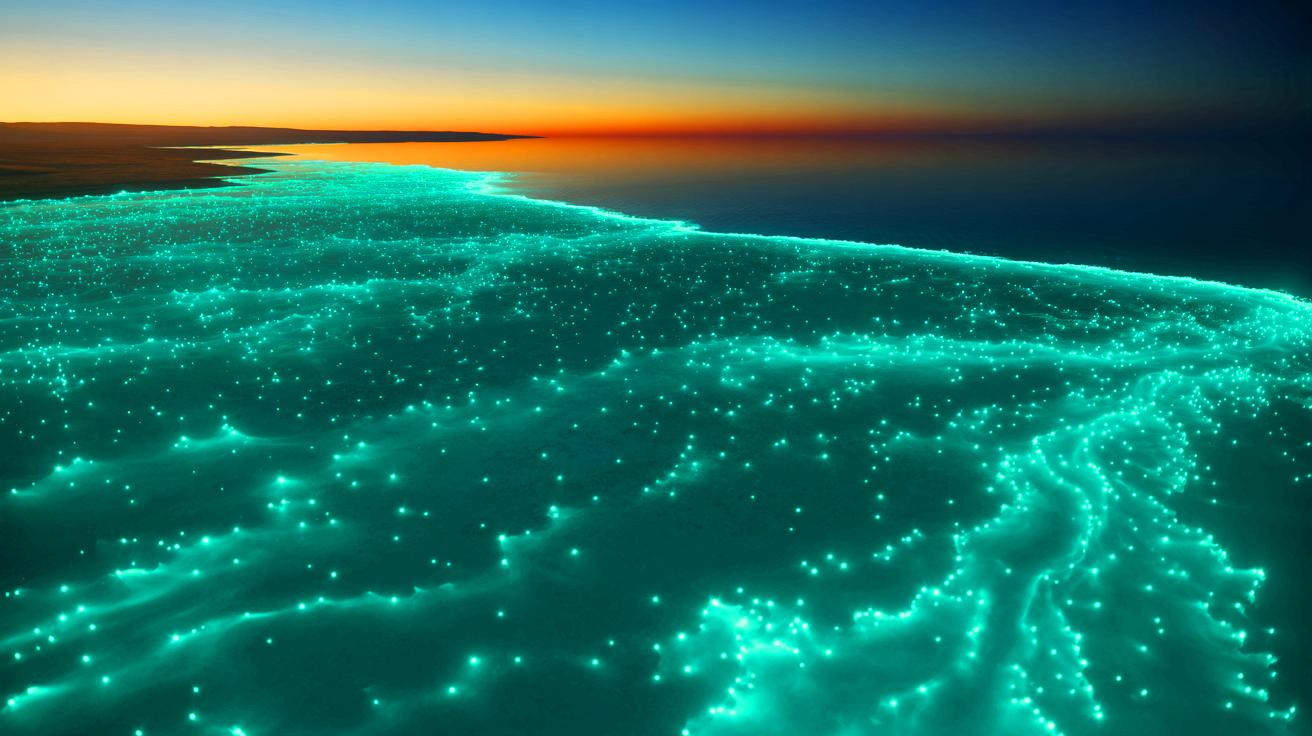- 🌊 NASA satellites captured a stunning turquoise glow, revealing a massive bioluminescent phytoplankton bloom off Australia’s coast.
- 🛰️ The bloom was first observed by NASA’s PACE spacecraft, highlighting the seasonal patterns of these oceanic events.
- 🔬 The glow is caused by high concentrations of chlorophyll-a in the phytoplankton, vital for photosynthesis.
- 🐋 These blooms support a rich marine ecosystem, attracting blue whales and other sea life to the nutrient-rich waters.
In recent times, a captivating natural event has drawn significant attention from the scientific community and the general public. NASA’s satellites have captured a remarkable turquoise glow off the southern coast of Australia, signaling a massive bloom of bioluminescent phytoplankton. This phenomenon, visible from space, has reignited interest in the intricate processes occurring within our oceans. These glowing organisms not only create stunning visuals but also play a vital role in sustaining marine ecosystems and supporting diverse marine life.
NASA’s Satellite Observations: Unveiling Oceanic Phenomena
NASA’s PACE spacecraft was instrumental in detecting the bioluminescent glow between mainland Australia and Tasmania. Utilizing cutting-edge imaging technology, scientists have observed the ocean’s vibrant turquoise light. The region, known for its dynamic currents and deep channels, is a significant maritime route leading into Port Phillip Bay, near Melbourne. Capturing such detailed images from space provides critical insights into the oceanographic conditions of this area.
While this is not the first observation of its kind, previous satellite missions like Suomi NPP and Terra and Aqua have amassed extensive data on these phenomena. These repeated observations have enabled scientists to monitor the patterns and seasonal nature of these blooms. The consistent documentation of these events through satellite imagery highlights the ocean’s dynamic and ever-evolving nature.
The Scientific Explanation Behind the Turquoise Glow
The stunning turquoise glow is primarily attributed to high concentrations of chlorophyll-a in the phytoplankton. This green pigment is crucial for photosynthesis, allowing these microorganisms to thrive in the ocean’s photic zone, where sunlight penetrates the water. In this zone, phytoplankton absorb essential nutrients like nitrogen and phosphorus, released from the decomposition of marine life. This nutrient-rich environment supports their flourishing.
Oceanographer Jochen Kaempf from Flinders University has extensively researched these blooms. He explains that the green filaments visible from space indicate a widespread phytoplankton bloom along the shelf break, about 500 feet deep. The surrounding blue hues might result from sediment disturbance in shallower waters or the presence of other phytoplankton species. This interaction of marine elements underscores the complexity and beauty of oceanic ecosystems.
Ecological Significance of Phytoplankton Blooms
Phytoplankton serve as the foundation of the marine food web, supporting a vast array of oceanic life. Along the Bonney Coast, these blooms provide a critical feeding ground for various marine species. Annually, approximately 80 blue whales are drawn to the area, attracted by the abundance of krill and other small organisms that feed on phytoplankton. Moreover, these blooms sustain sardines, anchovies, tuna, crabs, and numerous fish species, making the region a vibrant hub of marine biodiversity.
Beyond their ecological role, these microscopic algae are vital for global oxygen production and climate regulation. NASA scientists highlight that observing such blooms from space emphasizes the significance of ocean circulation, nutrient cycling, and seasonal dynamics along the southern Australian coast. The presence of bioluminescent phytoplankton not only showcases the allure of microscopic marine life but also reminds us of the ocean’s essential role in supporting life on Earth.
Advancing Ocean Exploration: A Window into the Future
As ocean exploration advances, discoveries like the bioluminescent phytoplankton bloom off Australia’s coast offer invaluable insights into marine ecosystems. These phenomena captivate our imagination and underline the importance of oceanographic research in understanding climate change and maintaining ecological balance. With improvements in satellite technology, our capacity to monitor and study these events will enhance, paving the way for new scientific discoveries and environmental conservation efforts. What other hidden marvels lie beneath the ocean’s surface, waiting to be unveiled by our satellite observations?
As we admire the breathtaking glow captured from space, the significance of such natural phenomena extends beyond their visual appeal. These events remind us of the interconnectedness of life on Earth and the delicate balance that sustains our planet’s ecosystems. How will we continue to explore and protect these vital marine environments in the future?
This article is based on verified sources and supported by editorial technologies.
Did you like it? 4.4/5 (28)
